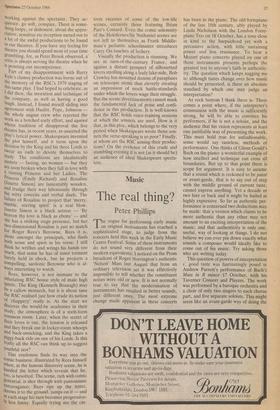Music
The real thing?
Peter Phillips
The vogue for performing early music on original instruments has reached a sophisticated stage, to judge from the concerts held this week in the Early Music Centre Festival. Some of these instruments do not sound very different from their modern equivalents: I noticed on the Prom broadcast of Roger Norrington's authentic `Nelson' Mass last August that from an ordinary television set it was effdctively impossible to tell whether the constituent noises were old or new. It is not normally true to say that the modernisation of instruments has resulted in .better sounds, just different ones. The most extreme change made apparent in these concerts
has been in the piano. The oldfortepiano of the late 18th century, ably played by Linda Nicholson with the London Forte- piano Trio on 18 October, has a tone close in kind to the harpsichord yet with a percussive action, with little sustaining power and less resonance. To hear a Mozart piano concerto played on one of these instruments presents perhaps the greatest test to anyone's faith in authentic- ity. The question which keeps nagging me is: although tastes change over how music should be presented, is there an absolute standard by which one may judge an interpretation?
At rock bottom I think there is. There comes a point where, if the interpreter's communion with the music is sufficiently strong, he will be able to convince his performers,, if he is not a soloist, and the audience that his vision represents at least one justifiable way of presenting the work. This must hold true for unfashionable, some would say tasteless, methods of performance. One thinks of Glenn Gould's Bach on the piano: a wonderful example of how intellect and technique can cross all boundaries. But up to that point there is scope for argument. It is easy to assume that a sound which is reckoned to be passé or avant-garde, that is to say out of step with the middle ground of current taste, cannot express anything. Yet a decade or two fore or back and it might be hailed as highly expressive. So far as authentic per- formance is concerned two deductions may be made: that a version which claims to be more authentic than any other may not amount to an exciting interpretation of the music; and that authenticity is only one, useful, way of looking at things. I do not believe we can ever pin down exactly what sounds a composer would ideally like to come out of his music. Try asking those who are writing today.
This question of powers of interpretation v. good taste was fascinatingly posed in Andrew Parrott's performance of Bach's Mass in B minor 17 October, with his Taverner Consort and Players. The work was performed by a baroque orchestra and a choir of only two singers to each chorus part, and five separate soloists. This might seem like an avant-garde way of doing the
piece, in fact there was never any doubt that it would be perfectly .acceptable to those who are used to performances with, say, six singers to a part, which are quite common. The choral society 40 to a part is now considered to be tasteless, and I shall be surprised if any record company pro- duces a new one of those. Since Parrott's ten chorus singers, and the orchestra too, made the most beautiful sounds, the coun- terpoint was as clear as it will ever be, the phrasing, though not unanimous, was intel- ligently done, the performance was a de- light to the ear.
But I have been brought up on Klemper- er's version and, compared with it, despite its technical excellence, this one lacked intellectual weight. Klemperer taught us something about the work which was so strong that it cannot be overlooked as fashions change. He made it possible to perceive that, as Samuel Langford once wrote in the Manchester Guardian about the Sanctus, 'the notes in their octave leaps are like vast pillars, not sunk into the deep but embracing in their height and depth an imagination of both earth and heaven; and if we add the sea, the combined images will not complete what one feels from the music. Such music, indeed, fulfils all those ideas in which music becomes a symbol of the universe.' The brisk tempi and the filigree texture of Parrott's conception made such thoughts quite foreign.
The best answer is that this style of performance should make a statement of similar importance. Just as Klemperer's version was by no means technically per- fect — its power came over despite that there were some details here which could perhaps be changed to good advantage. The most deleterious was that the chorus members were singing just about as loudly as they could from start to finish, to be heard over the orchestra. The ultimate view of 'absolute' counterpoint is that it does not matter much whether it is per- 'Sorry — I only do the foxtrot.' formed loudly or softly, since the argument is perfectly contained within the writing and, so long as everything can be heard, the listener needs nothing more. Since these singers could, remarkably, manage In this way, and thus balance the orchestra, there would be no complaint, if one did not instinctively wish for more resourcefulness in the lines. To produce a climax under these conditions one cannot crescendo, but simply add. When the trumpets and times joined in there was a considerable height- ening of the excitement; but Bach does not call for them very often. It must be desirable to have, for the asking, greater powers of chiaroscuro than this. By such means it may be possible to communicate more effectively. Bach might not have expected much ebbing and flowing, though no one can be certain of that; nor can one say how he would have felt after hearing a performance by Klemperer. There comes a point when it does not matter.



















































 Previous page
Previous page